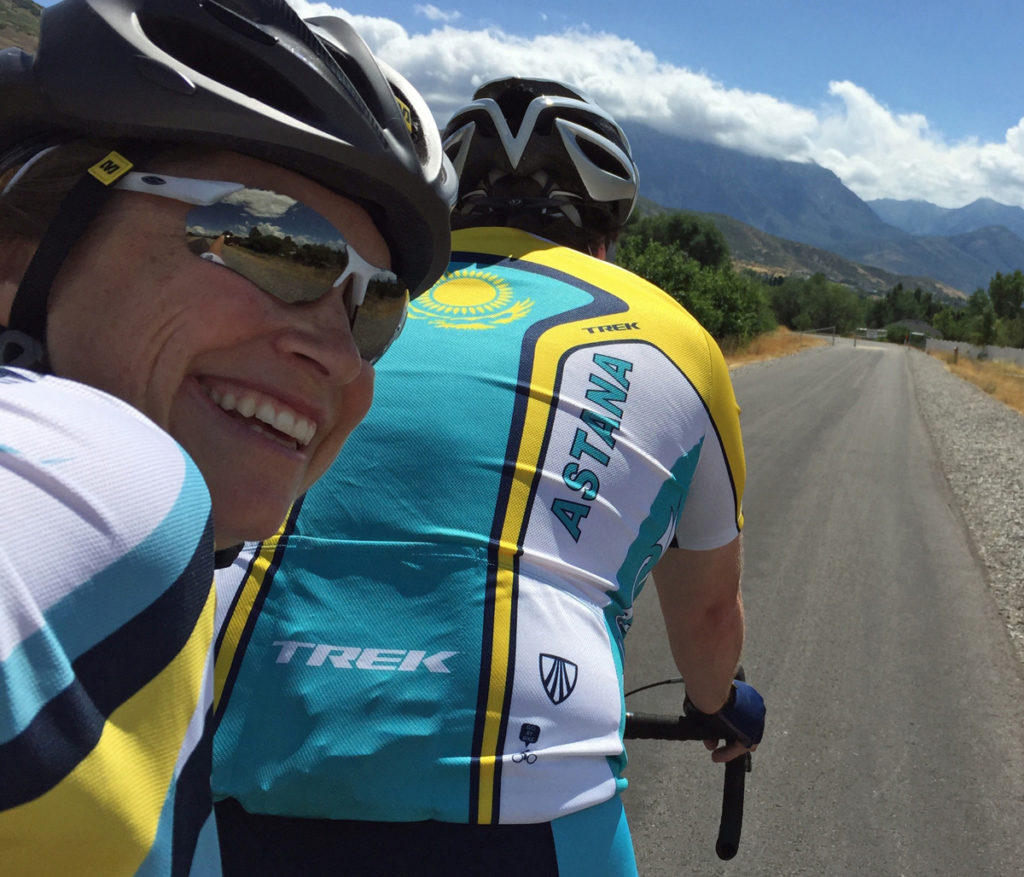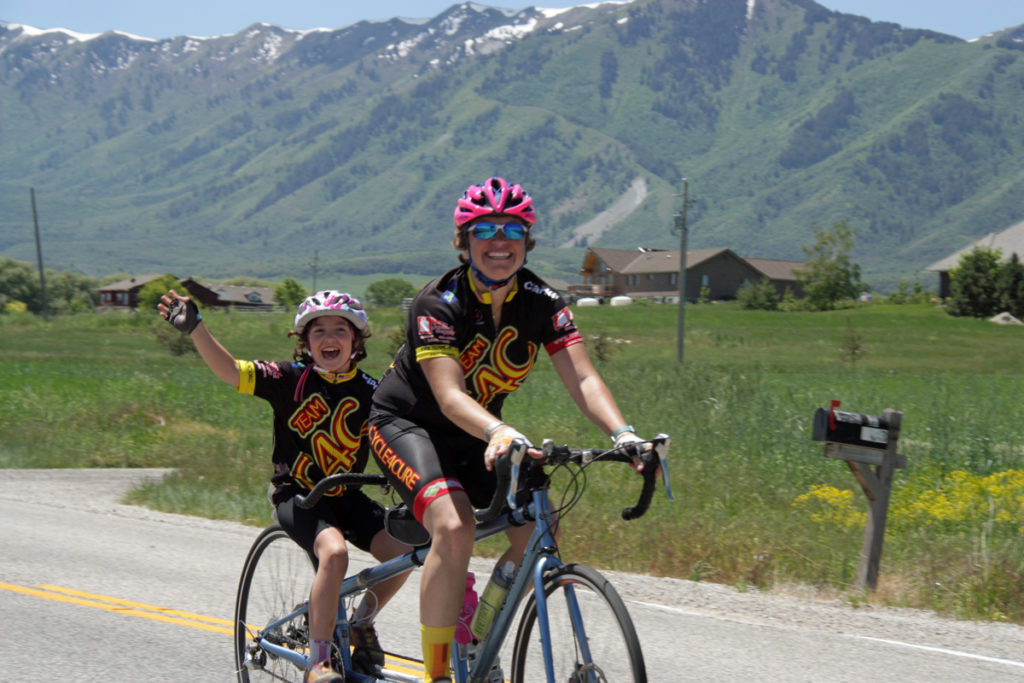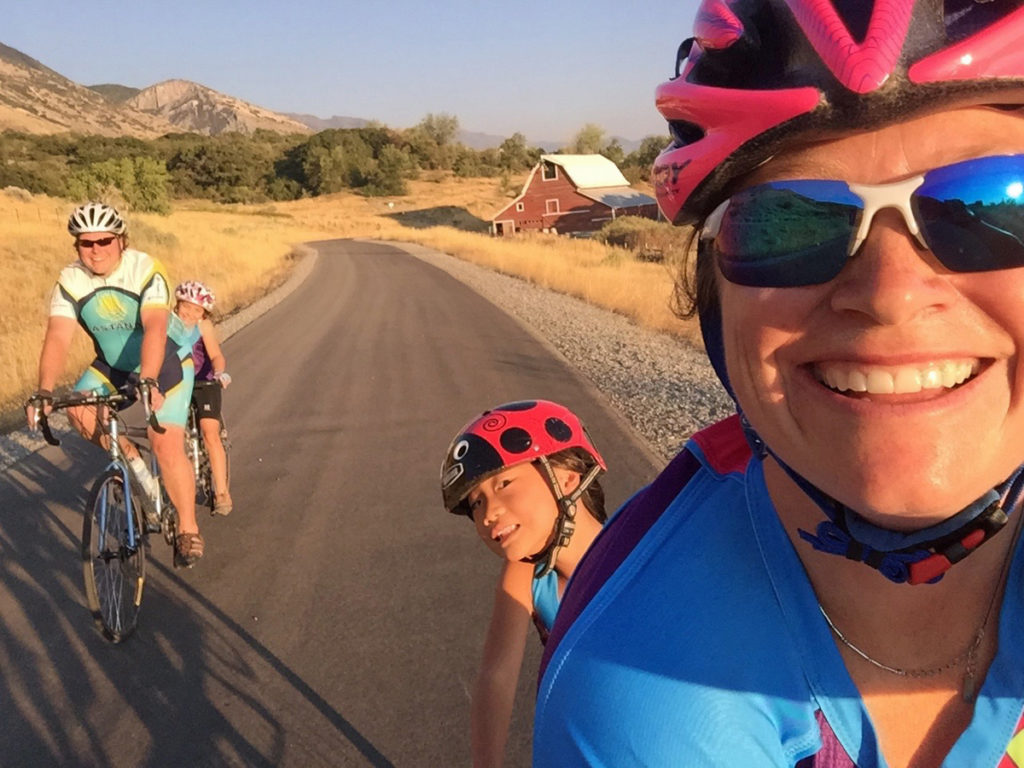By Jamie Morningstar – Last year my husband Steve and I embarked on a new adventure in cycling – riding in tandem. When somebody finds out that we ride a tandem bike, I inevitably get one of two reactions:
(from people who have never ridden tandem) Oh! I’ve always wanted to try riding a tandem with my spouse/kid/significant other!
(from people who have ridden tandem or are close to those who have) Oh! A divorce machine!

In our experience, riding a tandem bike requires a ton of communication and a lot of trust. It also makes for some quotable conversations. Here are a few favorite snippets from our first few weeks of tandem riding:
Steve: What the heck are you doing?
Jamie: Oh, yeah, I forgot that if I stop pedaling, you do, too.
(repeat this conversation about 300 times with both of us forgetting repeatedly that our feet move together)
Steve: Wait. If I have to spit, is it going to go on you?
Jamie: Dunno. Only one way to find out! (never fear, it didn’t)
Steve: Coasting. Stopping.
Jamie: Trusting.
Jamie: You know I say that so you don’t forget that if you don’t balance us I’m going to die.
Steve: Yeah, I got it.
Jamie: Don’t forget, I’m the one the cars are going to hit first!
Steve: With you on here, it’s like I have a tailwind all the time!
Steve: If you’re not nice to me, I’m going to fart.
The Benefits
The benefits of persevering through those first few tough rides have been huge. Riding together, not just side-by-side, is a whole new way to experience the outdoors as a couple.
I think we’re a darn good tandem pair and are learning to communicate better and better on the bike. We don’t panic unnecessarily and are always ready to laugh at ourselves, both of which seem to be necessary attributes of a tandem pair. Steve is letting the whole “Captain” title go to his head a bit, but since he gets hit with bugs in front and I don’t as stoker (the backseat rider), I’m calling it an even trade.
And as an added benefit, after getting the hang of our tandem bike I started taking our two daughters (ages 7 and 9) out for rides. I was surprised by how deeply I enjoyed sharing my love for cycling with my girls and how quickly they reciprocated that interest. Thanks to tandem cycling, for the first time in a long time I was able to get a good workout in and spend quality one-on-one time time with my kids.

My girls and I enjoyed riding together so much that that my older daughter, Sasha, and I started training fairly seriously and completed a full century together on the tandem this fall. We were proud finishers of Goldilocks Provo 2016, persevering through wind, rain, and seven-and-a-half hours in the saddle. Lugging 70 pounds of kid, 40 pounds of bike, and myself over 103 miles was one of the hardest things I’ve ever done, but the joy of finishing together and the pride in our joint accomplishment was well worth all the effort.

Finding a Bike
For my family, tandem cycling started as an experiment. We know several couples who purchased a tandem bike, rode it once, and immediately sold it – it just wasn’t a good fit for their personalities. So, not knowing whether or not we wanted to commit to tandem cycling for the long term, we decided to purchase a high quality used tandem bike in good shape. We figured that if we bought a used bike and ended up not liking or not using it we could probably sell it again for close to what we bought it for, so it was a pretty low-risk experiment. To lower your risk even more you could rent a tandem, but we found that all of the tandem rentals around us were beach cruiser-style models and we knew that when we took the plunge we wanted a road bike.
Bike sizing made our purchase decision more complicated. We wanted a tandem that either my husband (5’ 10”) or I (5’ 5”) could captain and one that I could ride stoker on but would also get small enough for our kids. Clearly this meant that we would be compromising on bike fit, but since this was an experimental purchase we decided that flexibility was key.
We ended up purchasing a Co-Motion Periscope Torpedo, a high-quality tandem that was a little too big for me and a little too small for my husband, but doable for both of us. We ended up really loving our tandem and purchased another used Co-Motion a few months ago, fitting one to my husband and one to me.
Getting Started
Once you have a bike, strap on your sense of humor and hop in the saddle! Even if you’ve been cycling for years, you’ll probably find that riding a tandem bike has its own learning curve. As with every aspect of cycling, I’m sure there are various perspectives on tandem technique. The tips below are what has worked for us and what seems to be internet best-practice. If you have a different approach that works for you, by all means do it!
Mounting the bike
First the captain gets on, straddles the top tube with both feet on the front, and puts his or her hands on the handlebars to stabilize the bike. Next the stoker gets on and puts his or her feet on the pedals, sitting on the saddle. This provides a much easier start than both riders keeping one or more feet on the ground, but can feel scary for the stoker. Captain, keep in mind that anything you do to wobble the bike will be very disconcerting to the stoker, so keep the bike as stable as possible.
Starting to ride
The benefit of the stoker keeping both feet on the pedals is that they can provide good forward momentum while the captain’s feet find the pedals. And we all know that staying balanced is much easier when you’re moving forward.
The stoker then backpedals to the point where the knee of the captain’s leading foot (whichever foot they like to start the stroke with) is a little above parallel to the ground, ready to stomp that pedal into motion. Captain, take a wide stance with your feet – failure to do so inevitably results in a pedal to the shin when the stoker backpedals.
Captain, now you put your leading foot on the pedal and keep your butt off of the saddle until you’re pedaling safely. Yes, this means that both of you are now propped up on the captain’s non-dominant foot. Did I mention this is an exercise in trust?
When we start, one of us gives a 3-2-1-going command and we both start pedaling strongly (pro tip: if you have a kid stoker, they’ll love being in charge of the countdown). Note that it’s important that you both pedal – the captain cannot start alone! Pedal smoothly and after 2 or 3 rotations you’ll start to feel balanced and in control. Commit to the start – a timid start makes it much harder to balance.
Stopping
The stoker has no control over steering, shifting, braking, and they can’t really see what’s in front of them. So, Captain, that means it’s your job to communicate clearly when you’re approaching a stop. We’ll usually call out a “downshift” and then a “coast” to tell what the stoker to expect.
Captain, remember that you’ll be starting a 35-40 pound bike with a stoker sitting on the saddle – you want to aggressively downshift before stops or it will be a very challenging start.
Also, Captain, you want to clearly call out the “coast” or else your stoker won’t know to let off on the pedals and will keep happily pedaling forward, pushing you forward when you wanted to slow. Clear communication from the captain is key to happy tandem riding.
Stoker, you keep your feet on the pedals. There’s no reason to put your feet down. Captain, you keep everybody stable. Now you can prep to start again as described above.
Turning
In general, as long as the stoker doesn’t fight the turns there’s not much to think about with turning. Captain, you’ll corner as if you’re riding your normal bike, except that your bike is twice as heavy and twice as long. Stoker, try to stay neutral.
More commands
Verbal communication on a tandem bike is the key to feeling confident and staying safe. Here are some other helpful commands to use:
“Bump” – Captain, your stoker can’t see what’s coming, and that means that when there’s a butt-crunching bump it will catch them completely and painfully by surprise unless you tell them it’s coming. Call out the bumps, Captains, or prepare to endure Stoker wrath.
“Shifting” – just like you don’t want to shift your road bike under load, you want to ease off of the pedals a little when shifting your tandem, especially when you’re preparing to climb. Calling out “shift” will tell your stoker to ease up on the pedals for the shift to complete.
“Off” or “Coast” – when you don’t want your stoker to give 100%, tell them so by giving them an “off” or “coast” command. If you don’t, they’ll unwittingly be fighting against your coast.
Pick a familiar, flat route and give it a whirl. Captain, know that in the beginning you need to verbally communicate every change to your stoker. Stoker, if the captain needs additional “reminders” to communicate, you have the ability to drive the pedal into his or her shin at the next stop. Stokers may not be able to see what’s in front of them, but they still have plenty of power.
Parting Advice
If you’re considering going tandem, go for it. Find a used bike in decent condition so you can re-sell it again if things don’t work out. Keep your sense of humor at the ready. And, trust me (this is the voice of experience talking): try to suppress the screams of terror bubbling up within you the first time you ride stoker. The shrieking only distracts the captain.












Interesting to read about your apparently self taught learning curve, but that backpedal/shin thing you have going on is absurd. Learn how to put your foot in a pedal while the cranks are turning forward! It’s easier, faster, and much safer.
I’ve ridden rented tandems with my wife around the top of the city wall in Xian, China, through the tulip fields of The Netherlands, and across the Golden Gate Bridge, as well as around Astoria Oregon. The Chinese tandems actually have the chain from the front pedals go all the way to the back wheel, so in reality only one of you needs to pedal. My wife loved that. I’ve also ridden tandem with a tagalong attached with two grandchildren in tow for Antelope by moonlight several times. Tandems are great, if you can get someone to go with you. I loved reading your article.
I loved your article. My wife and I have ridden a Co-Motion tandem on the Legacy Trail for several years; although this year we’ve only made it out together once. (I have a Trek 2100 I’ve been riding all year while waiting to go again.) I miss going out together. We go faster, farther, and more enjoyably together than alone.
Comments are closed.